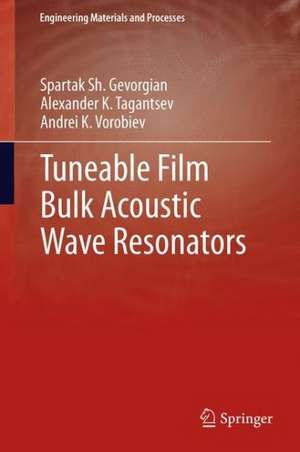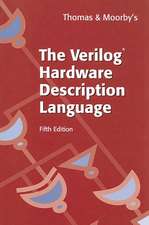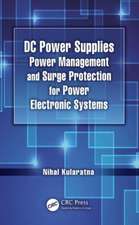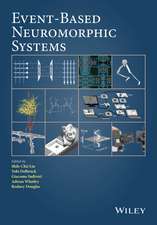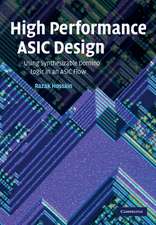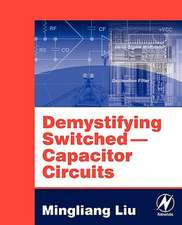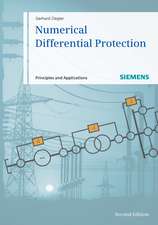Tuneable Film Bulk Acoustic Wave Resonators: Engineering Materials and Processes
Autor Spartak Gevorgian, Alexander Tagantsev, Andrei K Vorobieven Limba Engleză Hardback – 2 mar 2013
Tuneable Film Bulk Acoustic Wave Resonators discusses FBAR need, physics, designs, modelling, fabrication and applications. Tuning of the resonant frequency of the FBARs is considered. Switchable and tuneable FBARs based on electric field induced piezoelectric effect in paraelectric phase ferroelectrics are covered. The resonance of these resonators may be electrically switched on and off and tuned without hysteresis.
The book is aimed at microwave and sensor specialists in theindustry and graduate students. Readers will learn about principles of operation and possibilities of the switchable and tuneable FBARs, and will be given general guidelines for designing, fabrication and applications of these devices.
| Toate formatele și edițiile | Preț | Express |
|---|---|---|
| Paperback (1) | 638.76 lei 6-8 săpt. | |
| SPRINGER LONDON – 7 mar 2015 | 638.76 lei 6-8 săpt. | |
| Hardback (1) | 644.95 lei 6-8 săpt. | |
| SPRINGER LONDON – 2 mar 2013 | 644.95 lei 6-8 săpt. |
Din seria Engineering Materials and Processes
-
 Preț: 397.54 lei
Preț: 397.54 lei - 18%
 Preț: 1237.93 lei
Preț: 1237.93 lei - 18%
 Preț: 950.52 lei
Preț: 950.52 lei - 15%
 Preț: 646.30 lei
Preț: 646.30 lei - 18%
 Preț: 1383.00 lei
Preț: 1383.00 lei - 18%
 Preț: 1826.07 lei
Preț: 1826.07 lei - 5%
 Preț: 676.33 lei
Preț: 676.33 lei - 18%
 Preț: 1237.80 lei
Preț: 1237.80 lei - 18%
 Preț: 1228.62 lei
Preț: 1228.62 lei - 15%
 Preț: 644.95 lei
Preț: 644.95 lei - 15%
 Preț: 636.63 lei
Preț: 636.63 lei - 18%
 Preț: 1217.41 lei
Preț: 1217.41 lei - 20%
 Preț: 337.00 lei
Preț: 337.00 lei - 20%
 Preț: 557.20 lei
Preț: 557.20 lei - 15%
 Preț: 644.18 lei
Preț: 644.18 lei - 18%
 Preț: 956.50 lei
Preț: 956.50 lei - 18%
 Preț: 781.31 lei
Preț: 781.31 lei - 15%
 Preț: 640.06 lei
Preț: 640.06 lei - 23%
 Preț: 691.72 lei
Preț: 691.72 lei - 18%
 Preț: 941.50 lei
Preț: 941.50 lei - 18%
 Preț: 945.30 lei
Preț: 945.30 lei - 18%
 Preț: 952.09 lei
Preț: 952.09 lei - 15%
 Preț: 635.31 lei
Preț: 635.31 lei - 18%
 Preț: 1383.81 lei
Preț: 1383.81 lei - 18%
 Preț: 1222.45 lei
Preț: 1222.45 lei - 18%
 Preț: 1381.88 lei
Preț: 1381.88 lei - 18%
 Preț: 945.30 lei
Preț: 945.30 lei - 15%
 Preț: 640.02 lei
Preț: 640.02 lei - 18%
 Preț: 1545.72 lei
Preț: 1545.72 lei - 24%
 Preț: 848.84 lei
Preț: 848.84 lei - 18%
 Preț: 937.05 lei
Preț: 937.05 lei - 18%
 Preț: 1115.14 lei
Preț: 1115.14 lei - 15%
 Preț: 632.55 lei
Preț: 632.55 lei - 18%
 Preț: 948.79 lei
Preț: 948.79 lei
Preț: 644.95 lei
Preț vechi: 758.77 lei
-15% Nou
Puncte Express: 967
Preț estimativ în valută:
123.41€ • 129.20$ • 102.11£
123.41€ • 129.20$ • 102.11£
Carte tipărită la comandă
Livrare economică 05-19 aprilie
Preluare comenzi: 021 569.72.76
Specificații
ISBN-13: 9781447149439
ISBN-10: 1447149432
Pagini: 264
Ilustrații: XVIII, 243 p. 139 illus., 36 illus. in color.
Dimensiuni: 155 x 235 x 20 mm
Greutate: 0.54 kg
Ediția:2013
Editura: SPRINGER LONDON
Colecția Springer
Seria Engineering Materials and Processes
Locul publicării:London, United Kingdom
ISBN-10: 1447149432
Pagini: 264
Ilustrații: XVIII, 243 p. 139 illus., 36 illus. in color.
Dimensiuni: 155 x 235 x 20 mm
Greutate: 0.54 kg
Ediția:2013
Editura: SPRINGER LONDON
Colecția Springer
Seria Engineering Materials and Processes
Locul publicării:London, United Kingdom
Public țintă
ResearchCuprins
Dielectric and Acoustic Properties of Ferroelectrics and Piezoelectrics.- Models of FBARs.- Making Non-tuneable FBARs Tuneable.- FBARs Utilising Induced Piezoelectric Effect.- Designs of Tuneable FBARs.- Fabrication Processes and Measurements of FBARs.- Circuit Applications.- Conclusion and Challenges.
Notă biografică
Spartak Gevorgian has got his M.Sc. degree in radio engineering from Polytechnic Institute, Yerevan, Armenia in 1972, PhD (1977) and Dr. Sci. (1991) degrees from Electrical Engineering University, S. Petersburg , Russia. Currently he is a professor at the Department of Microtechnology and Nanoscience, Chalmers University of Technology, Sweden. He also works at Ericsson Research on part time bases. His research focuses on exploration of new materials and physical phenomena for application in agile microwave devices. He authored and co-authored more than 400 articles, papers and patents in the fields of microwave photonics, integrated optics, passive and agile microwave components. Tuneable microwave devices based on ferroelectrics and microwave integrated circuits have been the main subject in the last 10 years both at Chalmers University and Ericsson Research.
Professor Alexander K. Tagantsev received the B.S degree from St. Petersburg State University, in 1974, and Ph.D. degree from Ioffe Physico-Technical Institute, St. Petersburg, Russia, in 1982 in solid state physics. He joined the Ceramics Laboratory of Swiss Federal Institute of Technology (EPFL), Lausanne, Switzerland in 1993. Tagantsev is a theoretician of a broad domain of expertise from ferroelectricity and phonon physics to electrodynamics of superconductors. He is the author of key results on the theory of microwave dielectrics loss, dielectric polarization in crystalline materials, and relaxor ferroelectricity. He authored or co-authored more than 200 scientific articles and a comprehensive book on domains in ferroics.
Andrei Vorobiev received his M.Sc. degree in physics of semiconductors and dielectrics from the Gorky State University, Gorky, Russia, in 1986 and Ph.D. degree in physics and mathematics from the Institute for Physicsof Microstructures of the Russian Academy of Sciences, Nizhny Novgorod, Russia, in 2000. In 2008 he received title of Associate Professor in physical electronics from the Chalmers University of Technology, Gothenburg, Sweden. He now holds a research chair at the Chalmers University of Technology. His main research interests are in development and application of emerging functional materials and phenomena in microwave devices. Current activities focus on multiferroic and ferroelectric thin films including development of growth processes of thin films, fabrication processes and experimental investigation of microwave devices. Vorobiev and Gevorgian co-authored the book “Ferroelectrics in Microwave Devices, Circuits and Systems”. They are the inventors (patented) of tuneable FBARs based on induced piezoelectric effect.
Professor Alexander K. Tagantsev received the B.S degree from St. Petersburg State University, in 1974, and Ph.D. degree from Ioffe Physico-Technical Institute, St. Petersburg, Russia, in 1982 in solid state physics. He joined the Ceramics Laboratory of Swiss Federal Institute of Technology (EPFL), Lausanne, Switzerland in 1993. Tagantsev is a theoretician of a broad domain of expertise from ferroelectricity and phonon physics to electrodynamics of superconductors. He is the author of key results on the theory of microwave dielectrics loss, dielectric polarization in crystalline materials, and relaxor ferroelectricity. He authored or co-authored more than 200 scientific articles and a comprehensive book on domains in ferroics.
Andrei Vorobiev received his M.Sc. degree in physics of semiconductors and dielectrics from the Gorky State University, Gorky, Russia, in 1986 and Ph.D. degree in physics and mathematics from the Institute for Physicsof Microstructures of the Russian Academy of Sciences, Nizhny Novgorod, Russia, in 2000. In 2008 he received title of Associate Professor in physical electronics from the Chalmers University of Technology, Gothenburg, Sweden. He now holds a research chair at the Chalmers University of Technology. His main research interests are in development and application of emerging functional materials and phenomena in microwave devices. Current activities focus on multiferroic and ferroelectric thin films including development of growth processes of thin films, fabrication processes and experimental investigation of microwave devices. Vorobiev and Gevorgian co-authored the book “Ferroelectrics in Microwave Devices, Circuits and Systems”. They are the inventors (patented) of tuneable FBARs based on induced piezoelectric effect.
Textul de pe ultima copertă
To handle many standards and ever increasing bandwidth requirements, large number of filters and switches are used in transceivers of modern wireless communications systems. It makes the cost, performance, form factor, and power consumption of these systems, including cellular phones, critical issues. At present, the fixed frequency filter banks based on Film Bulk Acoustic Resonators (FBAR) are regarded as one of the most promising technologies to address performance -form factor-cost issues. Even though the FBARs improve the overall performances the complexity of these systems remains high. Attempts are being made to exclude some of the filters by bringing the digital signal processing (including channel selection) as close to the antennas as possible. However handling the increased interference levels is unrealistic for low-cost battery operated radios. Replacing fixed frequency filter banks by one tuneable filter is the most desired and widely considered scenario. As an example, development of the software based cognitive radios is largely hindered by the lack of adequate agile components, first of all tuneable filters. In this sense the electrically switchable and tuneable FBARs are the most promising components to address the complex cost-performance issues in agile microwave transceivers, smart wireless sensor networks etc.
Tuneable Film Bulk Acoustic Wave Resonators discusses FBAR need, physics, designs, modelling, fabrication and applications. Tuning of the resonant frequency of the FBARs is considered. Switchable and tuneable FBARs based on electric field induced piezoelectric effect in paraelectric phase ferroelectrics are covered. The resonance of these resonators may be electrically switched on and off and tuned without hysteresis.
The book is aimed at microwave and sensor specialists in the industry and graduate students. Readers will learn about principles of operation and possibilities of the switchable and tuneableFBARs, and will be given general guidelines for designing, fabrication and applications of these devices.
Tuneable Film Bulk Acoustic Wave Resonators discusses FBAR need, physics, designs, modelling, fabrication and applications. Tuning of the resonant frequency of the FBARs is considered. Switchable and tuneable FBARs based on electric field induced piezoelectric effect in paraelectric phase ferroelectrics are covered. The resonance of these resonators may be electrically switched on and off and tuned without hysteresis.
The book is aimed at microwave and sensor specialists in the industry and graduate students. Readers will learn about principles of operation and possibilities of the switchable and tuneableFBARs, and will be given general guidelines for designing, fabrication and applications of these devices.
Caracteristici
Provides readers with knowledge about principles of operation and possibilities of the switchable and tuneable film bulk acoustic resonators (FBARs) Includes general guidelines for designing, fabrication and applications of FBARs Describes the benefits of replacing fixed frequency filter banks by one tuneable filter, thereby addressing performance and cost issues Includes supplementary material: sn.pub/extras
